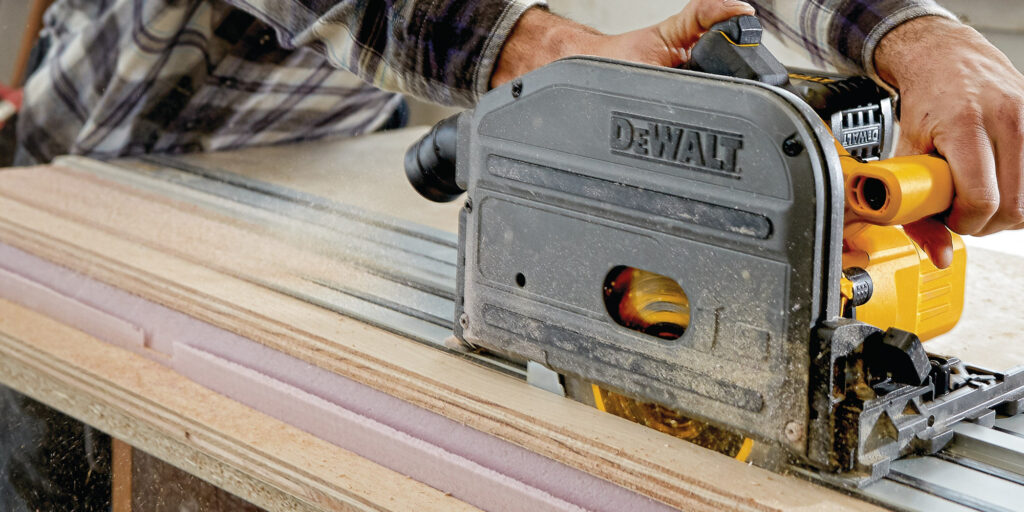If you’re a DIY enthusiast or a professional woodworker, you might be wondering if investing in a track saw is a smart decision. Well, look no further because we’re here to help you make that decision! In this article, we’ll explore the benefits of a track saw and whether or not it’s worth the investment. By the end, you’ll have a clear understanding of whether a track saw is the right tool to take your woodworking projects to the next level. So, let’s get started!

This image is property of i.ytimg.com.
What is a track saw?
Definition
A track saw is a powerful cutting tool designed to achieve precise and straight cuts in various materials, most commonly wood and plywood. Also known as a plunge saw, a track saw consists of a circular saw blade mounted on a guide rail or track, which provides enhanced stability and accuracy during cutting.
How it works
The track saw operates by running the circular saw blade along the guide rail, allowing for controlled movement and preventing the blade from veering off course. This setup ensures that the saw cuts in a perfectly straight line. The saw blade is also equipped with a depth adjustment feature, allowing users to control the cutting depth according to their needs.
Key features
Track saws come with several key features that contribute to their efficiency and effectiveness. One of the most prominent features is the anti-kickback mechanism, which helps prevent the saw from moving backward, reducing the risk of accidents. Additionally, many track saws have dust extraction systems to keep the work area clean and clear of debris. Some models also offer bevel cutting capabilities, allowing users to make angled cuts.
Advantages of using a track saw
High precision and accuracy
One of the primary advantages of using a track saw is its exceptional precision and accuracy. Thanks to the guide rail, a track saw ensures that your cuts are perfectly straight, eliminating the need for complex measuring and marking techniques. This level of precision is especially crucial for intricate woodworking projects or when aligning wood pieces is essential.
Versatility
Track saws are highly versatile tools that can tackle a wide range of cutting tasks. Whether you need to rip boards, crosscut sheets, or make bevel cuts, a track saw can handle it all. With the ability to adjust the cutting depth, track saws can also tackle various materials of different thicknesses, making them ideal for both professional and DIY projects.
Clean and splinter-free cuts
Another significant advantage of using a track saw is the consistently clean and splinter-free cuts it produces. The guide rail prevents the saw blade from wandering, resulting in smooth and precise cuts without tear-out or splintering. This feature is especially advantageous for cabinetmakers, carpenters, and anyone who values the quality and appearance of their finished projects.
Portability and convenience
Track saws offer the convenience of portability, enabling you to take your cutting tool directly to the workpiece instead of moving heavy materials to a stationary saw. The lightweight design of track saws, along with their compact size, makes them easy to transport and maneuver around job sites. This portability is particularly beneficial for carpenters, contractors, and enthusiasts who frequently work in different locations.
Safety features
Track saws prioritize user safety with features designed to minimize the risk of accidents. The anti-kickback mechanism included in many track saw models prevents the sudden backward movement of the saw, ensuring stability during operation. Additionally, some track saws have retractable riving knives that prevent wood from pinching the blade, reducing the chances of kickbacks. The use of dust extraction systems also contributes to a safer working environment by keeping the cutting area free from sawdust and debris.
Disadvantages of using a track saw
Cost
One of the primary disadvantages of investing in a track saw is the upfront cost. Compared to other cutting tools, track saws can be relatively expensive. However, it’s important to consider the long-term value and benefits that a track saw can provide. While the initial investment may be higher, a track saw’s precision, versatility, and clean-cutting capabilities can save time, effort, and materials in the long run.
Limited cutting depth
While track saws offer excellent precision and accuracy, they do have a limitation when it comes to cutting depth. The maximum cutting depth of a track saw is generally less than that of a traditional circular saw or table saw. This restriction may pose a challenge when working with thick materials or when deep cuts are required. However, for most woodworking and DIY projects, the cutting depth provided by a track saw is sufficient.
Dependency on track
Track saws rely on the guide rail or track for stability and accuracy. While this dependency is necessary for achieving precise cuts, it also means that the track must be used at all times. This requirement may limit the flexibility of the tool, especially in situations where using a track is not feasible or when working with irregularly shaped materials. However, the versatility and precision offered by the track often compensate for this limitation.
Applications and common uses
Carpentry and woodworking
Track saws are extremely valuable tools in the field of carpentry and woodworking. They are used to make straight cuts when building cabinets, furniture pieces, and other wooden structures, ensuring precise and professional results. Whether it’s ripping boards, crosscutting sheets, or trimming down large panels, a track saw is a go-to tool for carpenters.
DIY projects
For DIY enthusiasts, track saws provide an excellent cutting solution. They offer the versatility to tackle a wide range of home projects, such as cutting flooring, trimming doors, installing shelves, and building custom furniture. The accuracy and ease of use that track saws provide make them an essential tool for DIYers looking to achieve professional-looking results.
Cutting large panels or sheets
When working with large panels or sheets of materials like plywood or MDF, track saws excel in delivering precise and clean cuts. The guide rail ensures that the cuts are perfectly straight, regardless of the size of the material. This makes track saws particularly useful in projects that involve cutting large components, such as building custom cabinets or installing large wall panels.
Trimming door bottoms
Track saws are perfect for trimming door bottoms to ensure a perfect fit. With a track saw, you can easily and accurately trim the bottom of a door to the desired height without the need for elaborate setups or removing the door from its hinges. This saves time and effort, allowing for efficient and precise door adjustments.
Creating straight and long cuts
One of the main advantages of track saws is their ability to create long and precise cuts. Whether it’s cutting a straight line on a long piece of trim or ripping down a long board, a track saw guarantees a perfectly straight cut from start to finish. This level of accuracy is especially valuable in projects where precise measurements and straight lines are crucial.

This image is property of i.ytimg.com.
Factors to consider before investing in a track saw
Budget
Before investing in a track saw, it’s essential to consider your budget. Track saws generally range in price, with higher-end models offering more advanced features and durability. Assess your needs and allocate a budget that aligns with your requirements and the level of precision and versatility you desire.
Frequency of use
Consider how often you anticipate using a track saw. If you plan on using it frequently for various projects, investing in a high-quality track saw may be a wise decision. However, if you anticipate occasional use for specific applications, a more basic model might be sufficient to meet your needs.
Skill level
Your skill level and experience in woodworking should also influence your decision. If you are a beginner, a track saw with user-friendly features and intuitive controls may be more suitable. On the other hand, if you are an experienced woodworker looking for advanced features and precise cutting capabilities, a more professional-grade track saw may be worth considering.
Type of projects
Consider the types of projects you typically undertake. If you frequently work with large panels, sheets, or doors, a track saw would be a valuable addition to your toolkit. However, if your projects mainly involve small, intricate cuts, a track saw may not be necessary, and a more compact cutting tool may suffice.
Availability of track and accessories
Track saws often come with various accessories, such as additional tracks, connectors, and clamps. Before purchasing a track saw, ensure that the necessary accessories are readily available for future expansion or replacement. It is also important to ensure that the track system is compatible with the track saw you are considering.
Comparison with other cutting tools
Circular saw
Compared to a circular saw, a track saw offers distinct advantages. While circular saws can be versatile and portable, they often lack the precision and accuracy provided by a track saw. The guide rail on a track saw eliminates the need for measuring and marking lines, ensuring consistently straight cuts. Additionally, the anti-kickback mechanism enhances safety during operation.
Table saw
Table saws are powerful cutting tools commonly used in woodworking shops. They offer a large cutting surface and can handle heavy-duty tasks. However, table saws can be bulky and require dedicated space. In contrast, track saws offer enhanced portability and convenience, allowing users to bring the saw to the workpiece rather than moving the material to the saw. Track saws also tend to be more affordable compared to high-end table saws.
Miter saw
Miter saws, also known as chop saws, are designed for making angled cuts, particularly for trim work and molding. While track saws offer bevel cutting capabilities to some extent, miter saws excel in this area. If your projects mainly involve angled cuts, a miter saw may be a more suitable choice. However, if you require both straight and angled cuts, a track saw can still provide the versatility needed.

This image is property of i.ytimg.com.
Recommended track saw brands and models
Brand A – Model X
Brand A’s Model X is a highly rated track saw known for its exceptional precision and reliability. With a robust motor and smooth maneuverability, this track saw offers versatility for a wide range of cutting tasks. Its user-friendly features make it suitable for both professionals and hobbyists alike.
Brand B – Model Y
Brand B’s Model Y is a popular choice among woodworkers and carpenters. Its compact design and lightweight construction make it easy to transport and use in various work environments. Despite its portable nature, Model Y does not compromise on accuracy and power, making it an excellent option for those seeking a balance between precision and portability.
Brand C – Model Z
Brand C’s Model Z is a top-of-the-line track saw that caters to the needs of professional woodworkers and contractors. With advanced features such as integrated dust extraction, enhanced motor power, and extended cutting capacities, Model Z provides unmatched performance and durability. Its precise cutting capabilities and exceptional build quality make it a preferred choice for those who demand the best in their woodworking projects.
Customer reviews and testimonials
Positive experiences
Many customers have praised the precision and reliability of track saws in their reviews. They appreciate the ability to achieve clean and accurate cuts consistently, eliminating the need for extensive sanding or further refinement. Users also highlight the ease of use and portability of track saws, citing their convenience for various woodworking projects.
Negative experiences
Some users have expressed concerns about the limited cutting depth offered by track saws. While track saws can typically handle most common cutting tasks, there may be instances where a heavier-duty cutting tool would be more suitable. Users also note that the upfront cost of track saws can be a deterrent for those on a tight budget, especially if they only require occasional use.

This image is property of i.ytimg.com.
Cost analysis and return on investment
Initial investment
While track saws may have a higher upfront cost compared to other cutting tools, they offer long-term value through their precision and versatility. By investing in a track saw, users can achieve professional-grade results, minimizing the need to purchase additional tools or spend excessive time on refinishing projects. Therefore, the initial investment in a track saw can pay off through improved efficiency and reduced material wastage.
Savings on replacement blades
Track saws are designed to maintain the sharpness of their blades for extended periods. With the ability to make precise cuts consistently, track saws reduce the likelihood of blade damage caused by going off course or hitting knots in wood. This results in savings on replacement blades, making track saws a cost-effective choice in the long run.
Time saved on cutting tasks
The accuracy and ease of use of track saws save significant time on cutting tasks. Users can avoid the need for complex measurements and marking, as well as the time-consuming process of sanding and refining cuts. With a track saw, projects can be completed efficiently and with minimal effort, enabling woodworkers to take on more tasks within the same timeframe.
Quality of finished projects
The precision and clean-cutting capabilities of a track saw contribute to the overall quality of finished projects. The absence of tear-out and splintering ensures a professional appearance, reducing the need for additional finishing work. This high standard of workmanship can lead to increased customer satisfaction and potentially higher demand for woodworking services, further enhancing the return on investment.
Conclusion
In conclusion, a track saw is undoubtedly a valuable tool for woodworking enthusiasts, DIYers, carpenters, and contractors alike. With its high precision, versatility, and clean-cutting capabilities, a track saw offers numerous advantages over other cutting tools. While it may come with a higher initial cost, the long-term value, time savings, and improved quality of finished projects make the investment worthwhile. By carefully considering factors such as budget, frequency of use, skill level, and the types of projects you undertake, you can choose a track saw that best suits your needs. With the right track saw in hand, you can achieve professional results and elevate your woodworking experience to new heights.

This image is property of woodworkercentral.com.
